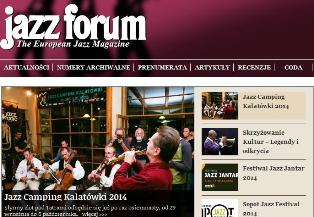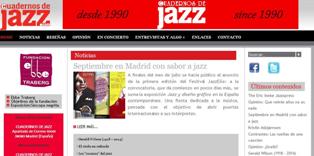
Jazz websites around Europe written primarily in a language other than English point to two main preoccupations.
One is a fascination, like any good local, regional, or national newspaper, on any given subject, to zoom in on the topic closest to hand geographically. The web hasn’t actually changed that need in a basic information sense. And two, there’s an abiding attraction to where the music began, in America, making some sort of connection either via an iconic musical figurehead, such as John Coltrane, or a socio-political leader (for instance Dr Martin Luther King). Connecting the local scene to the US seems to create the best of both worlds. One new website, as you’ll see below, has even named itself after one of bebop's catchiest tunes making yet another cultural connection.

French site jazzmagazine.com, the online presence of a well-known print magazine, references the US jazz experience, and the New Thing in particular, in the shot used in its print edition’s Archie Shepp and John Coltrane cover.

In Norway it's US jazz again, and history once more, at new site Salt Peanuts, its title inspired by a bebop tune. Albums reviewed include the latest by retro jazz vocalist Cyrille Aimée. The main picture is of Scandi-jazz and multi-kulti icon, Don Cherry.

Local national jazz preoccupations are in focus on the front page of Jazz Forum, the Polish magazine’s online presence, with a report on the annual Jazz Camping festival. Look closely and you can see Zbigniew Namysłowski, the great Polish saxophonist, in the photograph, leading the ensemble.

The website of Germany’s most vibrant jazz magazine Jazz Thing unites the historical theme of the struggle for civil rights by African-Americans with the upcoming Dr Martin Luther King-themed celebration taking place ahead of this year's Berlin Jazz Festival.

In Italy Musica Jazz, again like many historic print magazines online, is torn between promoting the print magazine and producing standalone articles, which it does in some abundance and handsomely so. In the example above you can see the print edition’s leaning towards some of the brightest new hard bop stars to come along in quite some time on the US scene in JD Allen and James Brandon Lewis, while by contrast in another adjacent article piano jazz lovers over 40 also seem to be well catered for in a more commercial offering!

The Spanish magazine Cuadernos de Jazz goes local with a look at the new Jazzeñe festival. But again obituaries of US jazz icons who have died recently also reinforce the link to a strong interest in American jazz.
Ideas of local and international reach seem to melt into one online, just as the subject of music in its graphic representation can be seen as a universal language vaulting over linguistic obstacles on all these sites.
The fact that all these websites are in a language other than English does not distinguish them from US or UK sites that are. The local scene in question and the US scene again are of great interest although in the US coverage of the non-US jazz world takes more of a back burner despite some token coverage.
• Further reading: The theme of jazz in a global and glocal sense as well as music as analogous to a spoken language (eg genre styles sharing an equivalence with dialects) are explored in Stuart Nicholson’s new book Jazz and Culture in a Global Age.